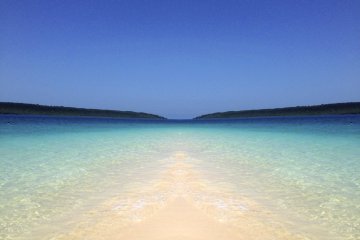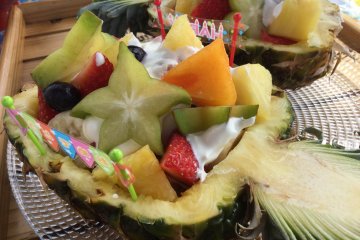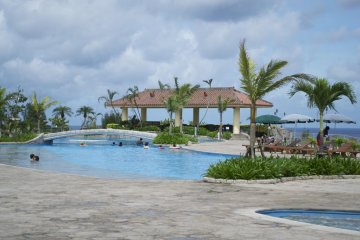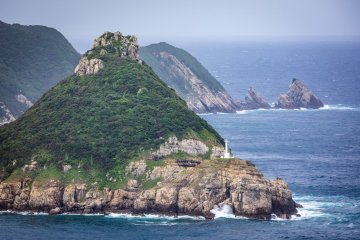Are you an adventure-seeker with a passion for history and diving? Then get ready to explore one of the world's most mysterious underwater sites—Yonaguni!

🔍 I filmed the clips while diving! Watch my video to uncover the mystery:

Yonaguni is located in the westernmost region of Japan’s Okinawa island chain. The island offers not only breathtaking natural beauty but also a deep sense of mystery. Some divers and professors believe the structures are natural, shaped by erosion, while others argue they are man-made, possibly from an ancient civilization. To me, it was difficult to judge one or the other. When I saw some of the spots, they could have been formed naturally and vice versa. It's hard to believe such a giant turtle monument could have been created naturally. Features like step-like formations and carvings fuel the theory of human construction, but the true origins remain uncertain.
Professor Kimura Masaaki with the University of Ryukyu has suggested that the site may date back thousands of years, perhaps built by older civilizations. However, many divers and scientists disagree, proposing that the monument is a product of natural forces rather than human hands.
Could these submerged structures be the remains of an ancient civilization, or are they simply natural formations, shaped by time and the ocean's currents? The debate has reached global audiences, with the BBC covering Yonaguni’s mystery in 2021. You can read more about it here.

Kihachiro Aratake, a local scuba diver and tour operator, discovered the Yonaguni Monument in 1986. The monument is just 100 meters off the coast, and the site features massive stone formations that resemble ancient architecture, with structures that appear to include terraces, straight edges, and right angles. While still shrouded in mystery, it has been suggested that the site could be part of a larger submerged complex. Thus, Yonaguni is a popular destination for divers, researchers, and tourists alike, drawn by its unusual and enigmatic features today.

The monument is reachable by a shallow dive at just 10 to 15 meters. It is accessible for divers of all levels. However, the area can be subject to strong currents, so a certain level of experience is required to explore the site safely.
If diving isn’t your thing, you can still enjoy the monument by taking a glass-bottom boat tour, which runs once a day, and it offers a unique perspective of this enigmatic underwater wonder.
Is Yonaguni’s monument a gateway to an ancient past—or simply an awe-inspiring natural wonder? Dive in or take a boat tour and decide for yourself!

Where is Yonaguni Island?
With a population of approximately 1,670 people, Yonaguni is home to both locals and military personnel due to the island’s strategic importance in international relations. Although Yonaguni is part of Okinawa Prefecture, it lies about 509 km away from Okinawa’s main island. Interestingly, the nearest island is Taiwan, which is only 111 km away. The second is Ishigaki Island at 119 km.

Please be aware that in Yonaguni, cash is still the primary payment method—credit cards and QR code payments are not accepted. While some dive shops and accommodations accept credit cards, most restaurants and local grocery stores are cash-only. Be ready to withdraw enough bills before landing the island since only the Japan Post Branch is available in Yonaguni.

After a thrilling dive, it's time to enjoy some local cuisine! Lunchtime is casual — just go and wait for your turn. As long as the restaurant is open, they’ll serve you delicious dishes. However, dinner is a different story. With limited restaurants available, many require reservations in advance. Some places even only serve lunch, so you may find yourself searching for food if you don’t plan ahead.

There is no direct flight from Tokyo to Yonaguni. Indeed, it’s not super easy to travel over if you live in Tokyo like me. Yet, it’s worth a visit if you are a history and travel lover!
Traveling from Tokyo, there are several options, depending on your budget and time availability. Here are the routes to consider:
-
From Tokyo (Haneda or Narita) to Naha (Okinawa’s main island): The flight takes approximately 2 hours and 30 minutes, with departures available from 6:25 am to 8:05 pm. Once you arrive in Naha, you will need to transfer to Yonaguni. There are only two daily flights from Naha to Yonaguni, at 7:15 am and 2:50 pm.
-
From Tokyo (Haneda or Narita) to Ishigaki: There are 5 flights available daily, from 6:45 am to 2:35 pm, with a travel time of approximately 3 hours and 10 minutes. After arriving in Ishigaki, you can take one of three daily flights from Ishigaki to Yonaguni: 10:05 am, 12:40 pm, or 5:50 pm. The flight between Ishigaki and Yonaguni is only 30 minutes.
-
Ferry from Ishigaki to Yonaguni: For those seeking a more scenic journey, a ferry service operates between Ishigaki and Yonaguni. The Ferry Yonakuni takes about 4 hours, with services running twice a week: Tuesdays and Fridays from Ishigaki to Yonaguni, and Wednesdays and Saturdays from Yonaguni to Ishigaki. The ferry departs at 10:00 am on these days, so you'll need to adjust your schedule accordingly.
While the ferry is equipped with comfortable sofa-like seats, vending machines, and berths for rest, it’s important to note that the journey can be rough. The ferry route passes through areas with strong currents, which may cause seasickness for some passengers. In fact, locals have nicknamed the ship “Gero-sen,” or "vomit ship," due to the occasional rough seas during the 4-hour trip. Be sure to check the official ferry website for any changes to the schedule, as it may be affected by weather conditions.



















